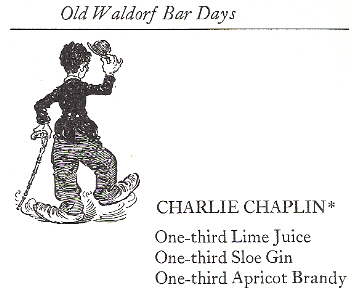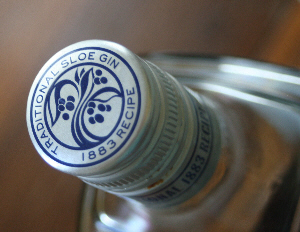 While I’m spouting off about drinks made with good sloe gin, I should bring up the Charlie Chaplin. This recipe comes from Old Waldorf Bar Days
While I’m spouting off about drinks made with good sloe gin, I should bring up the Charlie Chaplin. This recipe comes from Old Waldorf Bar Days by Albert Stevens Crockett, first published in 1931. Crockett indicates this is an original drink from the Waldorf, “named in [Chaplin’s] honor when he began to make the screen public laugh.”
This was another drink I’d overlooked when Plymouth Sloe Gin first came on the market, based on a quick read of the recipe: equal parts sloe gin, lime juice, and apricot brandy (a bit of a misnomer; usually “apricot brandy” refers to an apricot liqueur, not an apricot eau de vie). The combination looked way too sweet, so I tut-tutted and moved on with my recipe search. Thanks to Los Angeles uber-bartender and consultant Marcos Tello, who I spoke with while working on the sloe-gin story for Imbibe, I went back and took a closer look, and was pretty damn pleased with what I found.
Here’s where I initially went wrong: I approached this, and other sloe-gin recipes, with a flavor profile in my mind that was based on the cheaper versions of the spirit, which are usually oversweetened and mawkish. While I had that flavor in mind, thinking of a drink made with sloe gin and another liqueur made me want to drop the book and brush my teeth.
 But a good sloe gin such as those from Plymouth or The Bitter Truth have a flavor ruled by the tart, astringent quality of the sloe berry, without the heavy sweetness found in lesser sloe gins. Combined with a good ounce of lime juice and an apricot liqueur such as the Rothman & Winter Orchard Apricot, which is less sugary than some other brands on the market, the Charlie Chaplin is crisp and tart, with a rich stone-fruit flavor akin to that of the Savoy Tango that makes the drink so endearing.
But a good sloe gin such as those from Plymouth or The Bitter Truth have a flavor ruled by the tart, astringent quality of the sloe berry, without the heavy sweetness found in lesser sloe gins. Combined with a good ounce of lime juice and an apricot liqueur such as the Rothman & Winter Orchard Apricot, which is less sugary than some other brands on the market, the Charlie Chaplin is crisp and tart, with a rich stone-fruit flavor akin to that of the Savoy Tango that makes the drink so endearing.
Charlie Chaplin
- 1 ounce sloe gin
- 1 ounce fresh lime juice
- 1 ounce apricot liqueur
Combine ingredients in a cocktail shaker and fill with ice. Shake well and strain into chilled cocktail glass.
This drink is part of 30/30, a series of 30 drinks in 30 days — or as much as I can keep up before collapsing in a weary, booze-addled heap.

Would an older recipe like this really be calling for a drier apricot eau de vie instead of a liqueur? Much in the same way it calls for a more tart, “true” sloe gin?
I’ve got the Marie Brizard Apry. Will that work or do I have to cut back on it to prevent a sugarfest?
The age of the recipe shouldn’t have anything to do with which sort of apricot brandy that’s being called for in this instance; apricot brandy (the liqueur) and apricot brandy (the eau de vie) were around and in use long before Old Waldorf Bar Days was published. There is the trouble of nomenclature, though, I agree, and even within the same book sometimes both styles of spirit will be called for using the same name. At first blush I’d think that a Chaplin made with eau de vie would be unpalatably dry (since the sloe gin has some sugar but not nearly as much as most liqueurs, and that’s a whoppin’ load of lime juice in the drink), but hey, it’s worth a shot — you may be right.
Apry – it should work fine; you may want to dial it back just a bit, perhaps to 3/4 ounce, and see how it suits you.
After I thought about it, it sounds most appetizing as-is… with a decent sweetness to balance out the sloe and the lime.
I was thinking that the apricot might have suffered the same fate as the sloe: starting strong but becoming a cloying shadow of its former self over the years. But seems they’ve both always been around and there is surely plenty of room for both depending on the application.
Paul, thanks for writing about this one. I’ve been looking at the recipe for a while, but on paper it always sounded too sweet for my tastes, but I really like the finished drink. Lovely balance of sweet and tart.
We’re heading into Tequila Por Mi Amante season, and I’d like to give it a try with that. Remember Baker’s words, “We opine that handled in the same way as sloe gin, discoveries would be made . . . “
[…] mixing options should do just fine. Or you can honor your favorite Hollywood greats by serving Charlie Chaplins, Ginger Rogers, or toast to Shirley Temple with her signature […]